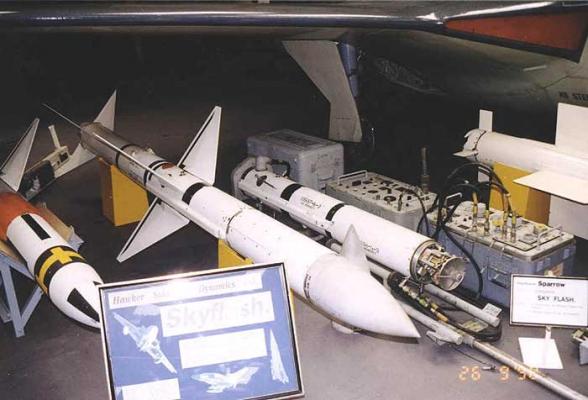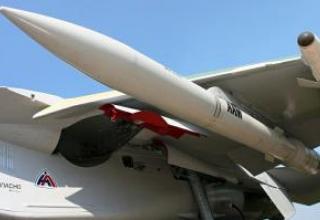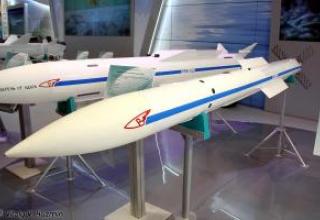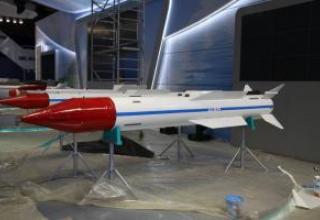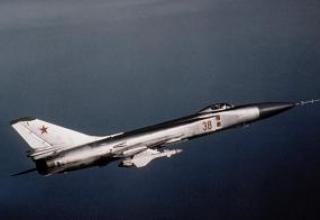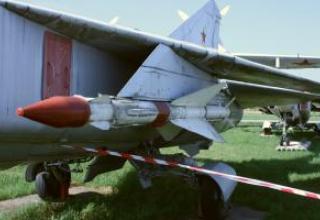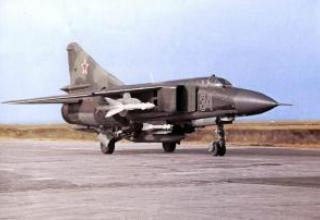Design of the British rocket "Skyflash" was started in 1973 by the British Aerospace company on the basis of the American rocket AIM-7E2 "Sparrow". At the stage of development work the missile had the index XJ521.
The principal difference between "Skyflash" and the American prototype is the homing head. It is equipped with a semi-active radar monopulse homing head, which has greater accuracy and better interference immunity than the homing head conical scanning missile AIM-7E2.
Flight tests of Skyflash missiles began in November 1975 in the United States at the Pacific Range. During the tests in the summer of 1976, of the seven missiles fired by F-4J fighters at air targets, six flew past targets within the kill range of the combat unit.
In 1978, the Skyflash missile was adopted by the British Air Force. It was armed with F-4, "Tornado", F-16 aircraft. The "Skyflash" missile is produced under license in Sweden under the index Av.71 to equip the Swedish fighter-interceptors "Viggen".
In the late 1970s in England began work to upgrade the rocket "Skyflash". The new missile was called "Active Skyflash".
Composition:
The "Skyflash" rocket has an aerodynamic scheme of the "duck" type with a crosswing and stabilizer. The missile retains the appearance of the AIM-7E2, wing compartment, 39.5 kg rods combat unit and the Aerojet Mk.52 Mod.2 or Rocketdyne Mk.38 Mod 4 engine. The 68.5 kg engine has an operating time of about 5 seconds.
The rocket "Skyflash" has radar semi-active inversion monopulse SOS of "Marconi" company, which consists of three main easily replaceable blocks: an antenna with a rotation mechanism, a receiver signals and a unit for their processing. The antenna is gyrostabilized and mounted on cardan suspension. The system works in Cartesian coordinate system, the maximum bearing angle is more than 40°. Light DC electric motors are used in the antenna drive, providing control by azimuth and angle of place. Receiver head has four receiving antennas, forming three channels of signal processing. PCBs are used in the design of the receiver and signal processing unit. Each subsystem of these units performs an independent function, which facilitates maintenance and repair.
A small signal-to-noise ratio and a narrow speed selection strobe in a monopulse receiver provide the SAT with good characteristics under conditions of interference and the ability to distinguish individual targets among aircraft flying in closed formation. Logic schemes of the signal processing unit provide protection against most types of interference. The high density of the COS components assembly, which was possible due to the use of solid-state circuits and other latest technology, made it possible to create a very compact design, occupying a cylindrical volume of 0.47 m long and 0.18 m in diameter. The COS is a functionally independent unit and is easy to remove, making it easy to operate. The COS unit is connected to the autopilot and power supply source as well as to the tail antenna of the reference channel.
The homing head of the Skyflash missile is optimized for joint use with the radar station, which has a continuous radiation channel. The choice of such a station, rather than a pulsed Doppler station, is explained by its greater cost-effectiveness, while a pulsed Doppler radar can be used to point missiles only if the pulse repetition rate is high, which requires a powerful, and therefore larger, and heavier energy source on the aircraft carrier.
The combat unit of the Skyflash missile is equipped with a more efficient radio detonator.
Autopilot and power supply unit is an upgraded version of the rocket A1M-7E. The function of the autopilot, the principle of which is based on the law of proportional guidance, is to support the flight of the rocket "Skyflash" on the intercept path by converting the CNS signals into side acceleration commands. The autopilot also receives data from a high-speed roll gyro to stabilize the SD on the roll.
The power source of the Skyflash rocket is a thermal battery. Their service life without inspection and maintenance is 10 years, its possible increase to 18.
The power source of the steering drive is a hydro accumulator. It consists of a cylindrical chamber pre-filled with gas, which is placed in an elastic rubberized bag located inside the tank with a slurry. When the rocket is launched, the gas chamber is punctured and the gas expands the elastic bag, which in turn presses the slurry, displacing it into the hydraulic system.
Characteristics:
| Body diameter, mm | 203 |
| Length, mm | 3660 |
| Wingspan, mm | 1020 |
| Range, km | 50 |
| Speed, M. | 4 |
| Start weight, kg | 195 |
| Weight BC, kg | 30 |
Testing:
The complex was not exported and did not participate in hostilities.
In 1972 the complex underwent modernization, the task of which was to reduce the lower boundary of the kill zone and provide the possibility of firing at maneuvering targets and inhalation. After modernization the complex was named "Storm-M" and in the same year it was adopted for service. On Apr. 1134A and 1134B the "Grom-M" control system served not only the SAM system, but also the "Blizzard" anti-submarine system.
In 1980-1986, the system was upgraded to fire low-altitude anti-ship missiles. The SAM system was named "Storm-N" and the missile was named B-611M (4K65).
Sources:
- В. Сапков "Системы наведения управляемых ракет класса "воздух-воздух". Зарубежное военное обозрение. №10, 1987.
- SKYFLASH/ACTIVE SKYFLASH Управляемая ракета средней дальности /Виртуальный авиационный справочник "Уголок неба"
